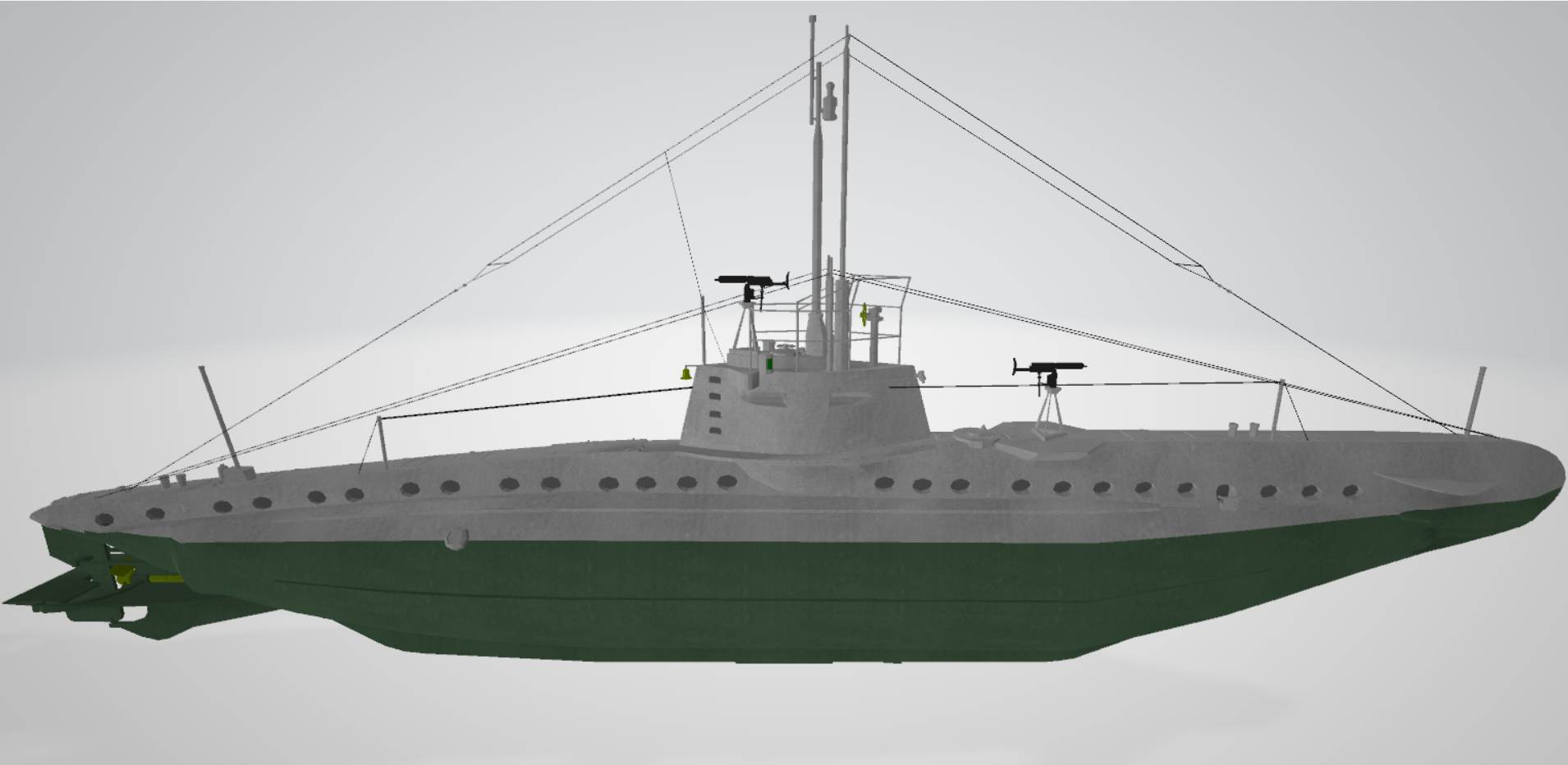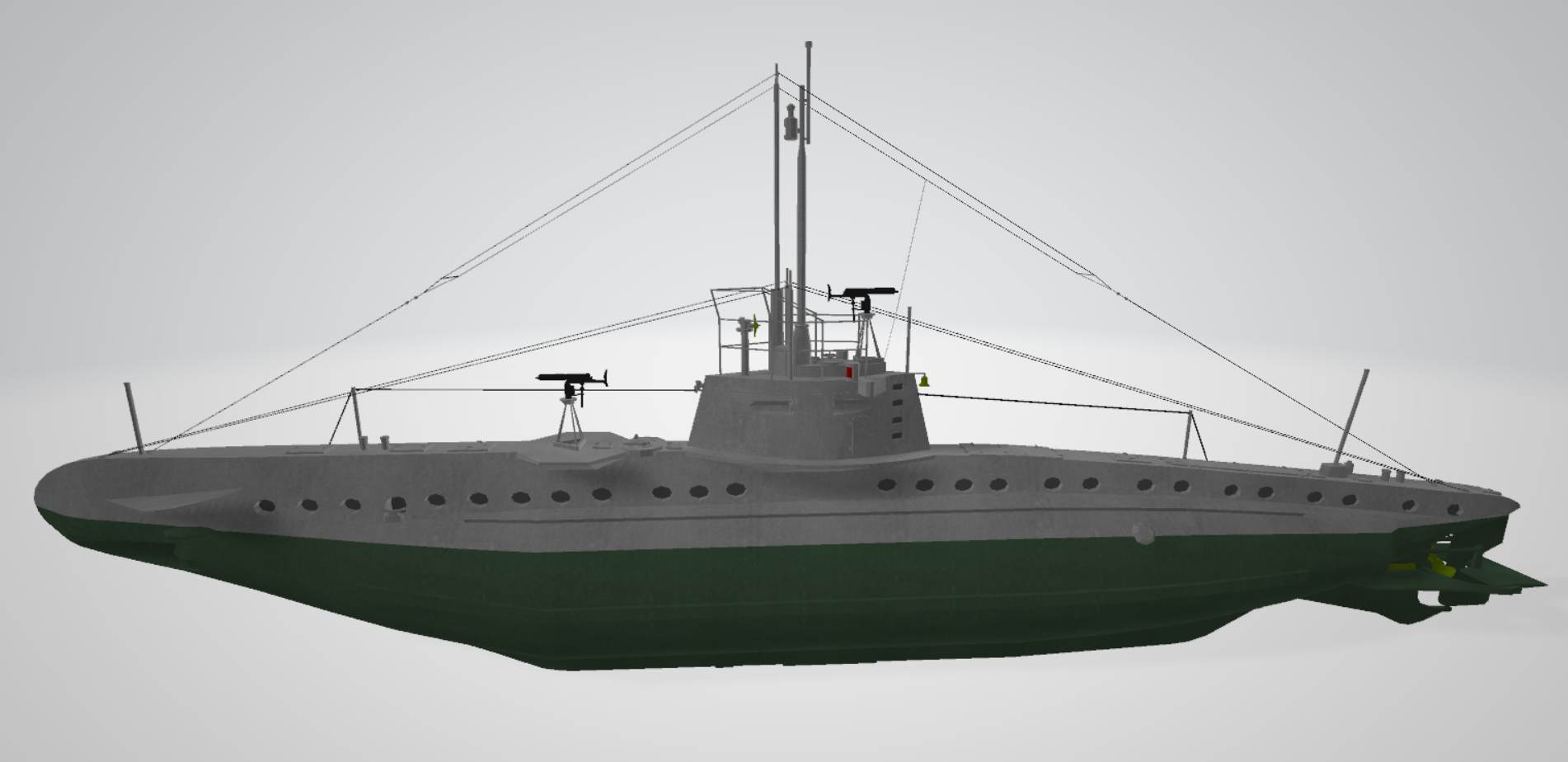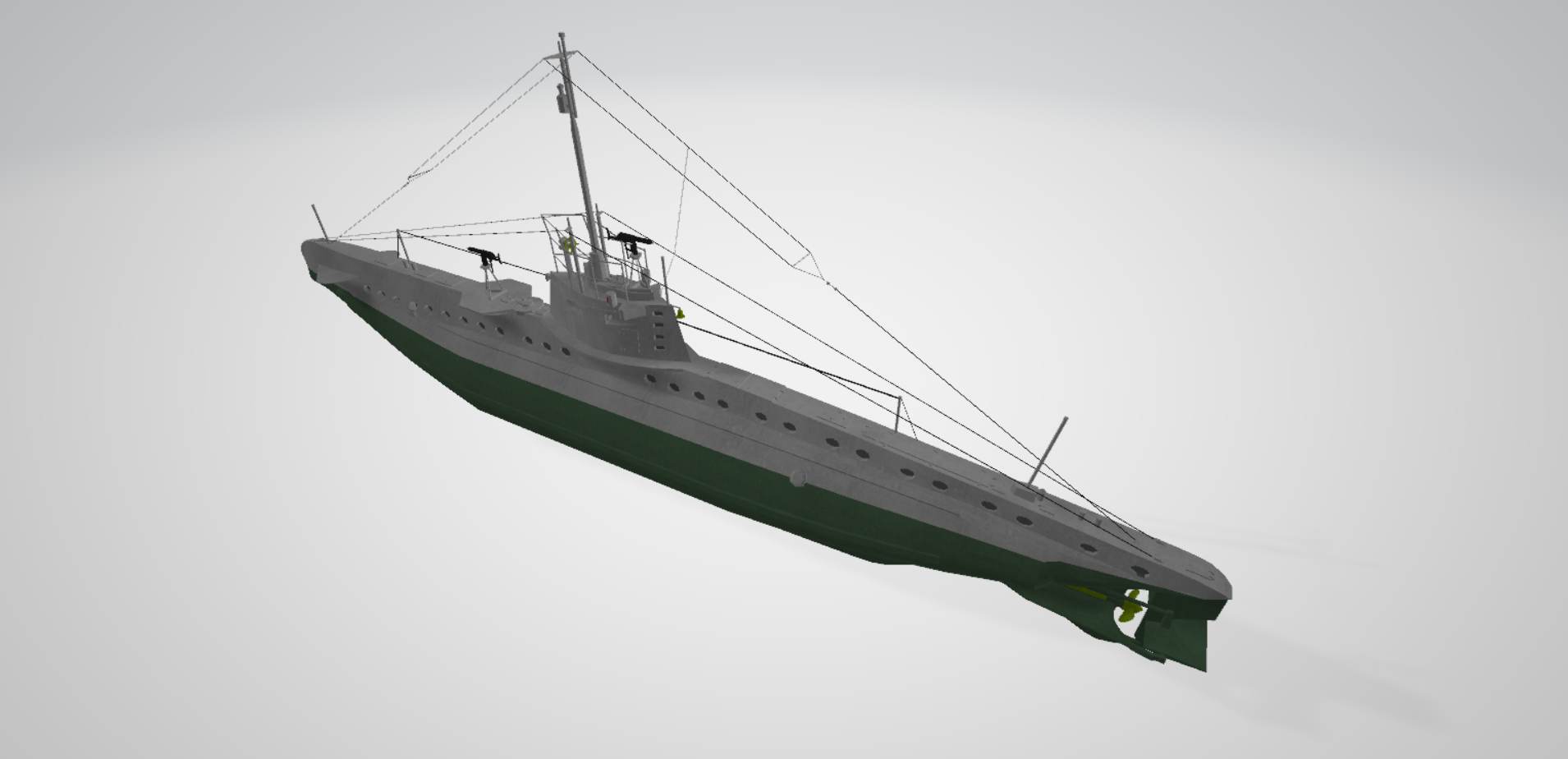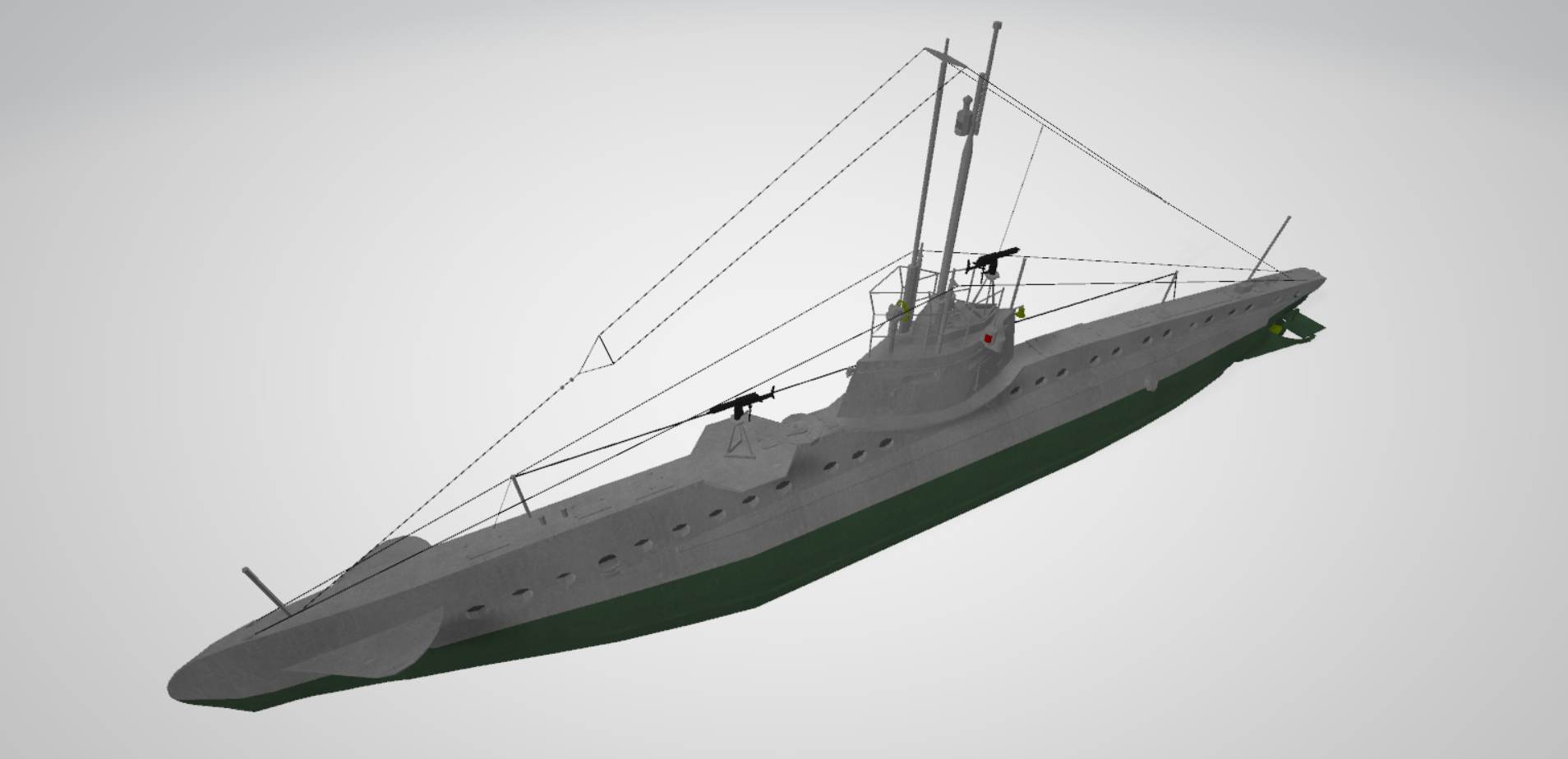

SMS UB16 1915
ONLY £ 25 EACH FOR ALL MODELS (Including for commercial use) !
VIEW OR BUY AND DOWNLOAD THIS PRODUCT
CLICK ON A PICTURE BELOW FOR LARGER IMAGE
 |
 |
 |
 |
SMS UB-16
SMS UB-16 was a German Type UB I submarine or U-boat in the German Imperial
Navy (German: Kaiserliche Marine) during World War I.
UB-16 and sister boat UB-17 comprised an order of two submarines placed
on 25 November 1914.
UB-16 was laid down at the AG Weser shipyard in Bremen in February 1915.
After work on UB-16 was complete at the Weser yard, she was readied for
rail shipment.
The process of shipping a UB I boat involved breaking the submarine down into what was essentially a knock down kit.
Each boat was broken into approximately fifteen pieces and loaded onto eight railway flatcars.
In early 1915, the sections of UB-16 were shipped to Antwerp for assembly
in what was typically a two- to three-week process.
After UB-16 was assembled and launched, she was loaded on a barge and taken through canals to Bruges where she underwent trials.
The submarine was commissioned into the German Imperial Navy as SM UB-16
on 12 May 1915.
She sailed under the command of Oberleutnant zur See (Oblt.) Hans Valentiner, a 26-year-old first-time U-boat commander.
On 1 June, UB-16 joined the Flanders Flotilla (German: U-boote des Marinekorps
U-Flotille Flandern), which had been organized on 29 March.
When UB-16 joined the flotilla, Germany was in the midst of its first submarine offensive, begun in February.
During this campaign, enemy vessels in the German-defined war zone (German: Kriegsgebiet), which encompassed all waters around the United Kingdom, were to be sunk.
Vessels of neutral countries were not to be attacked unless they definitively could be identified as enemy vessels operating under a false flag.
On 3 June, two days after joining the flotilla, Valentiner and UB-16 sank
three British fishing vessels while patrolling between 40 and 50 nautical
miles off Lowestoft.
All three of the sunken ships were smacks, sailing vessels traditionally rigged with red ochre sails which were stopped, boarded by crewmen from UB-16, and sunk with explosives.
On 12 June, UB-16 torpedoed and sank the 3,027-ton British cargo ship Leuctra
1.5 nautical miles (2.8 km; 1.7 mi) from the Shipwash Lightship.
Nine days later, the U-boat torpedoed the British steamer Tunisiana off Lowestoft.
After being hit, the 4,220-ton ship's master beached her on Barnard Sands to save the cargo of wheat shipped from Montreal, but the ship was a complete loss.
Tunisiana was the largest ship sunk by UB-16.
In her first month of action, UB16's totals were five ships sunk of 7,432 tons, more than half of the flotilla's June total of 14,080 tons.
No lives were lost on any of UB-16's June victims.
UB-16's next two successes came on consecutive days in late July.
On the 27th, Westward Ho!, a 57-ton smack was boarded and sunk by UB-16's crew 25 nautical miles (46 km; 29 mi) southeast of Lowestoft.
The following day, the 1,821-ton Mangara was torpedoed without warning one-quarter nautical mile (500 m) from the Sizewell Buoy at Aldeburgh.
Eleven men died when the ship and her cargo of iron ore were sent to the bottom.
Although the Flanders Flotilla sank 31 ships in August, UB-16 did not add
to that total.
In a four-day span in September, however, she accounted for three of the eight ships sunk by the flotilla during the month.
On the 7th, she sank two more fishing smacks, Emblem and Victorious, 44 nautical miles (81 km; 51 mi) from Lowestoft.
On 10 September, UB-16 sank the 51-ton Nimrod in the same vicinity.
-----------
Germany's submarine offensive was suspended on 18 September by the chief
of the Admiralstab, Admiral Henning von Holtzendorff.
This in response to American demands after German submarines had sunk the Cunard Line steamer Lusitania in May 1915 and other sinkings in August and September.
Holtzendorff's directive from ordered all U-boats out of the English Channel and the South-Western Approaches.
It also required that all submarine activity in the North Sea be conducted strictly along prize regulations.
UB-16 did not sink any vessels over the next four months, but resumed attacks
on 18 January 1916.
She sank three more smacks, - Evelyn, Foam Crest, and Sunshine -between 25 and 35 nautical miles (46 and 65 km; 29 and 40 mi) from Lowestoft.
By early 1916, the British blockade of Germany was beginning to have an
effect on Germany and her imports.
The Royal Navy had stopped and seized more cargo destined for Germany than the quantity of cargo sunk by German U-boats in the first submarine offensive.
As a result, the German Imperial Navy began a second offensive against merchant
shipping on 29 February.
The final ground rules agreed upon by the German Admiralstab and were Germany's
self-proclaimed war zone.
Ships would be destroyed without warning, that enemy vessels outside the war zone would be destroyed only if armed.
To avoid antagonizing the United States, enemy passenger steamers were not to be attacked, regardless of whether in the war zone or not.
UB-16's first successes in the new offensive came on 6 March when she sank
the smacks Springflower and Young Harry about 30 nautical miles east of
Lowestoft.
Valentiner and UB-16 attacked another pair of ships in early April.
The British ship Perth was torpedoed and sunk near Yarmouth on the 1st, while the Dutch sailing vessel Elziena Helena was damaged in an attack two days later east of Southwold.
On 5 April, Valentiner was succeeded by Kapitänleutnant Paul Hundius,
a 27-year-old, first-time U-boat skipper.
In the first two weeks under Hundius' command, UB-16 sank two British steamers:
The 2,978-ton Robert Adamson on the 10th, and the 3,091-ton Tregantle on the 22nd.
Robert Adamson was sunk 3 nautical miles (5.6 km; 3.5 mi) from the Shipwash Lightship while en route from Dundee to Le Havre with a cargo of props.
Tregantle had sailed from Galveston, Texas, via Norfolk, Virginia, with a load of wheat for Hull, but was sunk off Lowestoft.
Near the end of April 1916, Admiral Reinhardt Scheer, the newest commander-in-chief
of the German High Seas Fleet, called off the merchant shipping offensive.
He ordered all boats at sea to return, and all boats in port to remain there.
UB-16 did not sink any more ships for the next eight months.
-----
In mid-May, Scheer completed plans to draw out part of the British Grand
Fleet, the German High Seas Fleet would sortie for a raid on Sunderland.
He hoped to lure the British fleet across "'nests of submarines and mine-fields".
In support of the operation, UB-16 and five other Flanders boats set out
at midnight 30/31 May to form a line 18 nautical miles east of Lowestoft.
This group was to intercept and attack the British light forces from Harwich, should they sortie north to join the battle.
Unfortunately for Germany, the Admiralty had intelligence reports of the departure of the U-boats which, coupled with an absence of attacks on shipping, aroused British suspicions.
Delayed departure of the German High Seas Fleet for its sortie and several
of the U-boats stationed to the north to failed to receive a message warning
of the British advance.
As a result Scheer's anticipated ambush to was a "complete and disappointing failure".
In UB16's group, only UB10 sighted the Harwich forces, and they were too far away to mount an attack.
The failure to sink any British capital ships allowed the full Grand Fleet to engage the numerically inferior High Seas Fleet in the Battle of Jutland, which took place 31 May – 1 June.
--------
UB16's activities over the next two months are not reported.
On 2 August UB16 was patrolling off the Mass Lightship and torpedoed the Norwegian steamer John Wilson, sending her cargo of food destined for London to the bottom.
-------
Later in August, Scheer set up another ambush for the British fleet.
He drew up plans for another High Seas Fleet raid on Sunderland (as had been the original intention in May).
The German fleet planned to depart late in the day on 18 August and shelled
military targets the next morning.
As in May, UB-16 was part of a group intended to attack the Harwich forces.
She was one of five boats forming the second line of boats from the Flanders Flotilla, UB-16 was stationed off Texel by the morning of 20 August.
Once again, British intelligence had given warning of the impending attack
and ambush.
This causing the Grand Fleet to sortie at 16:00 on 18 August, five hours before the German fleet sailed.
Faulty intelligence caused Scheer initially to divert from Sunderland, and then to eventually call off the whole operation.
Although U-boats to the north sank two British light cruisers, UB-16 and her group played no part in the action.
--------
On 24 August, UB-16 was again patrolling off the Mass Lightship when Hundius
stopped Velox, another Norwegian steamer headed for London.
Crewmen from UB-16 boarded the 312-ton cargo ship, planted explosives, and sank the vessel and her general cargo.
Velox was the last ship sunk by the UB-16 for nearly eight months, and the last sunk by Hundius before he was replaced by Oblt Ernst Müller-Schwarz late in the month.
Neither Müller-Schwartz, nor his January 1917 replacement, Oblt Hans Ewald Niemer, sank any ships while in command of UB-16.
--------
By the time of the so-called "turnip winter" of 1916–17, the Royal
Navy blockade of Germany had severely limited imports of food and fuel into
Germany.
Among the results were an increase in infant mortality and as many as 700,000 deaths attributed to starvation or hypothermia during the war.
With the being so bad, Kaiser Wilhelm II approved a resumption of unrestricted submarine warfare to begin on 1 February 1917 to force the British to make peace.
The new rules of engagement specified that no ship was to be left afloat.
--------
With the new campaign already underway, Niemer was replaced as UB-16's commander
by Oblt Hugo Thielmann on 18 March.
Although only in command of UB-16 for little more than a month, Thielmann sank one ship on UB-16.
The 107-ton Dutch motor vessel Arie was sunk in the Hoofden area on 20 April; there were no reports of casualties.
Kapitänleutnant Wilhelm Rhein was assigned to UB-16 on 23 April.
Under his command, UB-16 may have been responsible for damaging the Norwegian cargo ship Kongsli on 26 April.
On 9 August, UB-16 torpedoed he sank the British destroyer HMS Recruit 3 nautical miles from the North Hinder Lightship.
HMS Recruit, commissioned four months earlier, sank with 54 of her complement.
Rhein was succeeded by Oblt Günther Bachmann on 26 August.
He, in turn, was succeeded by Oblt Alfred Krameyer on 25 December.
------
On 28 April, British forces attempted to block the canal at Zeebrugge and
bottle up the vessels of the Flanders Flotilla in the Zeebrugge Raid.
In the raid, the British succeeded in sinking two obsolete cruisers, Iphigenia and Intrepid, in the narrowest part of the canal.
British admiral Roger Keyes planned the raid and believed that the Flanders Flotilla ships would be bottled up for a long period of time.
The following day, after the Germans had removed two piers, UB16 under Oblt Vicco von der Lühe, her new commander made the first sortie from Zeebrugge after the raid.
Despite the fact that the British Zeebrugge Raid partially blocked the canal
on 28 April 1918, UB16 sortied from Zebrugge the following day.
--------
UB16 and three sister boats, UB10, UB12, and UB17, had all been converted
to minelaying submarines by 1918.
The conversion involved removing the bow section and replacing it with a new bow containing four mine chutes of two mines each.
In the process, the boats were lengthened to 105 feet, and the displacement increased to 147 tons on the surface, and 161 tons below the surface.
Exactly when this conversion was performed on UB16 is not reported, but
UB12 was at the dockyard from November 1916 to January 1917.
The lack of reported successes by UB16 during this same span makes it a possibility that her conversion was accomplished in a similar timeframe.
--------
On 13 March, UB16, now under the command of Oblt Rudolf Stier, was responsible
for sinking the 895-ton steamer Lisette near the Shipwash Lightship.
One month later, on 13 April, the fishing smack Ruth was boarded and sunk by UB16; Ruth was the final ship sunk by UB16.
UB16 departed Zeebrugge for what would be the final time on 6 May 1918 for
a patrol off Harwich.
At 18:50 on 10 May, the British submarine E34 spotted UB-16 on the surface near Harwich.
Although E34's commanding officer Lieutenant Pulleyne initially believed that UB16 was a British submarine.
He submerged out of caution because of UB16's proximity to Harwich.
After identifying the submarine as a German boat, Pulleyne manoeuvred to attack.
At 19:15, E34 launched two torpedoes at UB16 from a distance of 400 yards
(370 m).
The first hit UB16's bow and failed to detonate, but the second hit below the conning tower and exploded.
UB16 sank at position Coordinates: 52°6'N 2°1'E in less than five minutes.
After a further five minutes, E34 surfaced near where UB16 had gone down, and rescued von der Lühe from the oily water; he was the only survivor.
British divers dispatched to the site of UB16 a week later could only find some plating and a few pipes and concluded that UB16 had disintegrated after the torpedo hit.
------
Von
der Lühe was imprisoned in a British prisoner of war camp, where he
died of influenza on 1 March 1919.
VIEW OR BUY AND DOWNLOAD
THIS PRODUCT
BACK TO INDEX
(c) Copyright .................Virtual Dockyard.....................2021